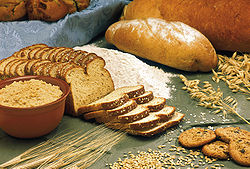
Back Малітва пасьля яды BE-X-OLD Birkat ha-mazon Czech Birkat hammazon Danish Birkat Hamason German Birkat Hamazón Spanish Birkat hamazon Finnish Birkat Hamazon French ברכת המזון HE Birkat Hamazon ID Birkat Hamazon Italian
 Birkat Hamazon is recited after consuming a meal eaten with bread | |
| Halakhic texts relating to this article | |
|---|---|
| Torah: | Deuteronomy 8:10 |
| Mishnah: | Berakhot ch. 7 |
| Babylonian Talmud: | Berakhot |
| Jerusalem Talmud: | Berakhot |
| Mishneh Torah: | Hilkhot Berakhot |
| Shulchan Aruch: | Orach Chayim 182 - 201 |

Birkat Hamazon (Hebrew: בִּרְכַּת הַמָּזוׂן, romanized: birkath hammāzôn "The Blessing of the Food"), known in English as the Grace After Meals (Yiddish: בענטשן, romanized: benchen "to bless", [1] Yinglish: Bentsching), is a set of Hebrew blessings that Jewish law prescribes following a meal that includes at least a kezayit (olive-sized) piece of bread. It is understood as a mitzvah (Biblical commandment) based on Deuteronomy 8:10.[2][3]
Birkat Hamazon is recited after a meal containing bread or similar foods that is made from the five grains, with the exception of bread that comes as a dessert (pas haba'ah b'kisanin)[4] and food that does not possess the form or appearance of bread (torisa d'nahama),[5] in which case a blessing that summarizes the first three blessings (birkat me'ein shalosh) is recited instead. It is a matter of rabbinic dispute whether Birkat Hamazon must be said after eating certain other bread-like foods such as pizza.[6]
Except in teaching situations, Birkat Hamazon is typically read individually after ordinary meals. The blessing can be found in almost all siddurs and is often printed in a variety of artistic styles in a small booklet called a birchon (or birkon, בִּרְכּוׂן) in Hebrew or bencher (or bentscher) in Yiddish. The length of the different brakhot hamazon can vary considerably, from bentsching in under half a minute to more than five minutes.[7]
- ^ Weinreich, History of the Yiddish Language
- ^ Palley, Kate. "What is Birkat Hamazon, or Benching?". MyJewishLearning.com. Retrieved 17 April 2016.
- ^ Klein, Isaac. "A Guide to Jewish Religious Practice". www.jtsa.edu. Jewish Theological Seminary of America, NY, 1988. Retrieved 17 April 2016.
- ^ Shulchan Aruch, Orach Chaim 168:6
- ^ Shulchan Aruch, Orach Chaim 168:11. See the Rema's gloss, which defines what torisa denahama means.
- ^ Pizza and birkat hamazon
- ^ The shortest known Birkat Hamazon would be that in the Siddur of Saadia Gaon. From: Bar-Hayim, David. "Birkat HaMazon: Is There Just One 'Proper' Nusah?". machonshilo.org/en/eng/component/content/article/34-featured/810-zimun-a-birkat-hamazon-how-does-it-work. Machon Shilo. Archived from the original on 2021-12-21. Retrieved 17 April 2016.